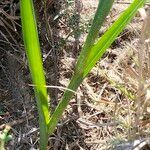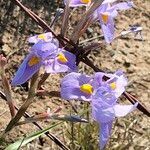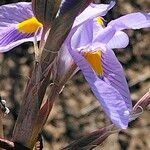Perennial herb, geophyte, 0.5-0.8 m high; corm tunics of dark brown, coarse fibres; stem erect, usually several-branched. Leaves 3-5, canaliculate, ± falcate or trailing above. Spathes 50-70 mm long, green, becoming dry above, attenuate. Inflorescence with violet to blue flowers; nectar guides yellow; tepals unequal, claws spreading, outer 36-55 mm long, reflexed, inner usually erect. Stamens: filaments united for lower 2/3, ± 10 mm long; anthers 8-10 mm long; pollen yellow. Ovary 6-10 mm long, cylindric to narrowly obovoid, with reddish veins; style branches ± 10 mm long, diverging; crests ± 20 mm long. Flowering time Jan.-Sept. Capsule ovoid, erect.
Cormous geophyte, up to 0.8 m high; with a much-branched aerial stem. Leaves several; blade linear, 6-12(-20) mm wide, not similar to spathes. Flowers: ovary 6-10 mm long, usually exserted from spathes; perianth with outer segments 36-50 mm long, violet to pale blue with yellow to orange nectar guides on outer segments; Mar.-Jun.
Cormous geophyte, 500-800 mm tall, much-branched. Leaves several, channelled, trailing above. Flowers enclosed in red-flushed spathes, blue with yellow nectar guides, tepal limbs lightly reflexed, occasionally inner tepals erect, style branches broad, crests erect. Mainly Mar.-June.
Cormous herb, up to 0.8 m high. Outer tepals 36-50 mm long. Ovary 6-10 mm long, usually exserted from spathes. Leaves linear, 6-12(-20) mm wide. Flowers violet to pale blue with yellow to orange nectar guides on outer tepals.
Cormous geophyte, 50-80 cm, much-branched. Leaves several. Flowers blue.



